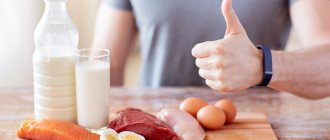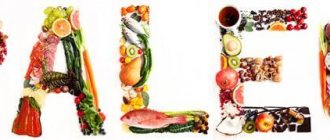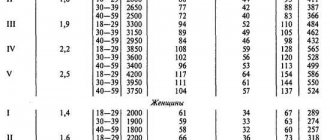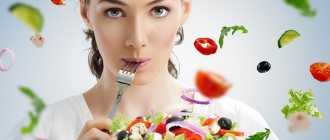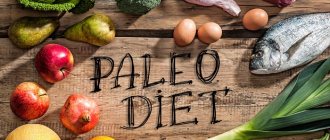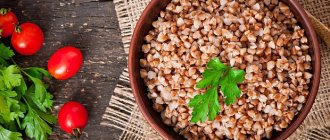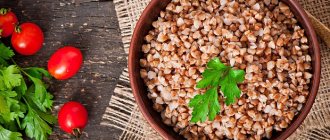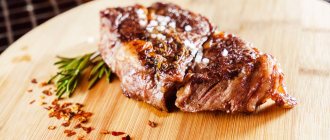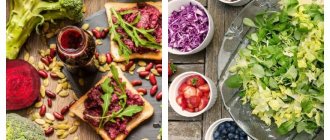In this article we will tell you:
- The essence of a low-carb diet
- How mitochondria work in the body
- 8 Types of Low Carb Diets
- Benefits of a Low Carb Diet for Weight Loss
- The benefits of a low-carb diet in fighting disease
- List of approved products
- Sample menu for the day
- Menu for the week
- Low carbohydrate diet for diabetes
- Low Carb Diet for Fatigue Adrenal Syndrome
Low carb diet
– it’s just a diet for one or two months, it’s a way of life. And although it has certain restrictions on products (for example, it is necessary to exclude soda, sugar, baked goods), it is not much stricter than the usual, but so vague in its understanding of proper nutrition.
Grilled meat, fish, fatty dairy products, berries, vegetables and a variety of greens - and with all this variety you can still successfully lose extra pounds! Isn’t this what every girl dreams of?! But, as with everything, there are pitfalls here - which is why we strongly recommend consulting with your doctor before switching to a low-carb diet.
The essence of a low-carb diet
Anyone who has ever tried to lose weight knows that to lose excess weight you need to give up sweets and starchy foods. True, most often fat-containing foods - butter, meat, cream, mayonnaise - are also excluded from the diet. As a result, girls, in an effort to achieve their dream figure, eat lettuce and green tea, which inevitably leads to breakdowns and even greater weight gain. This approach to losing weight is fundamentally wrong. To lose weight, you need to eat, you just need to eat a different diet from what you previously followed.
Moreover, many representatives of the fair sex forget: it is healthy fats that are the basis for the formation of sex hormones in the ovaries, adrenal hormones and vitamin D, which is responsible for the expression of several thousand genes!
Nutritionists are constantly studying the effect of certain foods on human health. The result of their work is various nutritional systems aimed at maintaining good health, a stable emotional background and achieving ideal physical shape. In the mid-2000s, Swedish scientists proved that widespread and massive consumption of sugar and starch, rather than fat, is much more harmful to the figure, as was previously believed. This led to a real revolution in nutrition.
Numerous new studies confirm: the real enemies for those losing weight who are purposefully moving, step by step, towards the cherished number on the scales are fast carbohydrates. These simple sugars are included in the digestion process already in the oral cavity. In response to their intake, the pancreas intensively produces and secretes insulin - a hormone of protein nature, the task of which, by facilitating the transport of glucose from the blood into the cells, returns the body to its original equilibrium values - that is, to homeostasis. It’s just the process of releasing this hormone that is important. Imagine a steep hill with an almost vertical rise and an equally sharp descent - this is what the insulin secretion graph will look like.
In other words, in our body, after eating another piece of candy, there is an instant increase in sugar levels and an equally rapid drop - a state of hypoglycemia develops after this. Observe your subjective feelings after, say, toffee, helpfully offered by a work colleague: at first there is an increase in strength and energy - and it seems to you that you are ready not only to get rid of your weekly report in an instant, but also to climb Everest. Ten, twenty minutes pass and performance decreases sharply. Fatigue occurs and headache appears.
Fat-containing foods have a completely different effect: they give the body a long-lasting feeling of fullness and provide it with energy that lasts for a fairly long period. Just compare: when carbohydrates are burned inside the furnaces of our body, the production factory in the form of cells and tissues receives a little more than 4 kilocalories, while fat brings in twice as much - 9 with a small tail.
Recently, another myth has been debunked: that for normal functioning the brain needs glucose, which supposedly can only be obtained from pure sugar. Large-scale research in the field of physiology and nutrition suggests the opposite: senile dementia is more often observed in those who love sweets, and those who have consumed moderate amounts of carbohydrates throughout their lives retain clear thinking until the end of their days.
We recommend
“What is dietetics and nutritionology: what are their differences” Read more
Indeed, nervous tissue uses glucose as substrates for energy (that is, the firewood that it sends to mitochondrial ovens) - this is a favorite, but far from the only way to ensure its vital functions. With prolonged fasting and a decrease in the intake of carbohydrates from food, our brain, at first, of course, reluctantly, but switches from gasoline to gas - or rather from glucose to ketone bodies.
Doctors recommend seriously reducing the carbohydrate content in the diet for patients with type II diabetes, cardiovascular diseases, polycystic ovary syndrome, Alzheimer's disease and acne.
A low-carbohydrate diet for weight loss is very easy for many women to tolerate because it is not accompanied by attacks of hunger. Adherents of this eating style note that they do not experience cravings for eating foods containing large amounts of sugar and starch. In this regard, there is no need to clearly regulate the amount of carbohydrates allowed, however, nutritionists still give certain recommendations - from 20 to 100 g of carbohydrates per day. Naturally, the source of their supply should be cereals, vegetables and fruits, but not refined sugar and premium flour (and even more so refined).
The principles underlying the low carb, high fat (LCHF) diet are simple and straightforward:
- It is necessary to eat only when a feeling of hunger appears: thus, constant consumption of food affects the sensitivity of satiety centers located in one of the key structures of the brain - in the hypothalamus, on leptin. This hormone, produced by adipose tissue, is the main piece on the satiety chessboard.
- Don't get caught up in counting calories. Of course, we all remember the main rule: spend more than you receive - and although it is quite debatable in other areas of human life, it still plays a significant role in nutrition.
However, constantly counting the calories eaten and the subsequent feeling of guilt if you did not fit into the daily norm only entails a weakening of the emotional background - and then losing weight results in psychosis. Add sufficient physical activity and make sure that satiation does not automatically equate to overeating - and then you definitely won’t need very conventional calorie calculations using apps on your phone.
- Consume only natural fats, resolutely refusing synthetic ones.
- Keep food processing to a minimum.
- Eat with pleasure, receiving physical and aesthetic pleasure. Stay alone with your plate - don’t let phones, newspapers and TVs distract you from eating: don’t forget that digestive juices are secreted even before the food touches the taste buds of the mouth - this is the so-called cerebral or complex reflex phase of secretion.
There are no serious contraindications for a low-carb diet, but people with chronic diseases (in particular, fatigued adrenal syndrome) should consult their doctor. Insulin-dependent patients and patients with cardiovascular problems should take into account the characteristics of their condition and follow the recommendations of nutritionists.
What does 20 grams of carbohydrates look like?
For example, a meal consisting of 4 ounces of roasted pork tenderloin, ½ plate of spinach and ⅔ plate of sweet potatoes contains about 20 grams of carbohydrates, which is just one meal. One serving of fruit or vegetables - about 15 g of carbohydrates; One serving of dairy provides about 15 grams of carbohydrates at the absolute minimum.
So on this diet, you'll consume very small amounts of fruits, vegetables, dairy, and grains—four of the five recommended food groups. As a result, you'll eat mostly protein and fat rather than processed, junk food. If this is not something you want every day, then this meal plan is not for you.
How mitochondria work in the body
It would seem, why would a person far from science understand such a complex issue? However, understanding the basics of cell functioning will allow us to better understand what processes take place in the depths of our body. We will only touch on the topic of the effect of ketones and insulin on mitochondrial activity to show exactly how we can improve our health simply by making changes to our diet.
Mitochondria function
– extracting energy from food, combining it with oxygen and synthesizing adenosine triphosphate (ATP), which is the basic unit of energy in an animal cell. Mitochondria are present in every cell of the body, with the exception of red blood cells - red blood cells are forced to provide themselves through slightly different processes of glucose transformation.
Insulin plays an important role in this process. It depends on it exactly how the body will use the generated energy: spend it on current needs or store it for a rainy day. An increased level of insulin triggers synthesis reactions, including fats. This is the hormone of ANABOLISM - that is why everything grows on it: muscles (due to increased formation of proteins) and cancer cells (in fact, the basis of the tumor is uncontrolled division).
A deficiency of carbohydrates leads to the fact that insulin is produced in limited quantities - just enough to cover the body's need for it. This triggers the process of ketogenesis: fatty acids are converted into ketones, which serve as fuel for cells - including neurons in the brain, as previously mentioned.
Is it possible to eat zero carbs?
No. And you shouldn't even try. Technically you could if you only ate meat and only drank water, but there are no health benefits. While low-carb diets are safe and can help you stay healthy, completely eliminating carbohydrates from your diet will leave you unable to maintain normal body functions, not to mention make you go crazy with boredom.
Benefits of a Low Carb Diet for Weight Loss
Research strongly supports the effectiveness of a low-carbohydrate diet for weight loss. At the same time, people do not feel hungry and do not experience constant cravings for prohibited foods. This is explained by the specificity of protein breakdown and the sufficient calorie content of fats.
A low-carbohydrate diet helps quickly get rid of fat deposits in the abdominal area, including visceral fat around the internal organs. This significantly reduces the risk of heart disease, type 2 diabetes and certain types of cancer.
Research shows that overweight people who ate a high-fat, low-carbohydrate diet for 4 months experienced significant weight loss compared to those on a low-fat diet.
Another advantage of a low-carb diet is the long-term preservation of the achieved results. There is evidence that daily consumption of less than 50 g of carbohydrates allows you not only to get rid of excess weight, but also to forget about such a problem as obesity for a long time. Thus, information has been published according to which 88% of experiment participants following a low-carbohydrate diet lost 10% of their initial weight and maintained the results throughout the year.
Targeted nutrition tips
that will increase your energy level by 10 out of 10
From TOP nutritionists of the MIIN
Get tips
The main difficulty for many losing weight is the irresistible craving for foods containing fast sugars. A high-fat version of a low-carbohydrate diet helps overcome addiction to sweets and starchy foods faster than a diet limited in fat. In addition, including fatty foods in the menu better suppresses the feeling of hunger, allowing you to do without breakdowns.
How much protein should you eat on a diet?
Signs of your body's natural hunger and satiety dates back long before people started measuring the nutritional value of food in numbers. Eating more protein will make you feel fuller than grains, starches, and fruits because it takes longer for your body to absorb the protein. A balanced intake of protein with some complex carbohydrates (especially fiber) is great for improving digestion, which in turn is beneficial for effective weight loss.
If you really need a certain amount you should aim to consume, it's 1.8 grams of protein per kilogram of body weight.
The benefits of a low-carb diet in fighting disease
Excess weight causes the appearance of many pathological conditions, so it is necessary to get rid of the accumulated kilograms, even if there are no tangible health problems yet. A low-carbohydrate diet should be the mainstay of nutrition for patients with diabetes, heart disease, reproductive disease and neurological disease.
- Diabetes
Changing the diet to reduce carbohydrates while increasing fat has multiple beneficial effects in obese patients with type 2 diabetes. By adhering to such a diet, they stabilize blood glucose levels and can take lower dosages of pharmacological drugs prescribed for this pathology.
- Neurological disease
For people with epilepsy, a low-carbohydrate diet has long been recommended as a simple and effective way to reduce the risk of seizures. For Alzheimer's disease, as well as to prevent its occurrence, neurologists advise including more high-fat foods in the diet and minimizing the consumption of simple carbohydrates.
According to some data, a low-carbohydrate diet has a positive effect on the cognitive abilities of older people, and an addiction to sugar and processed carbohydrates, on the contrary, leads to the rapid development of senile dementia.
- Heart diseases
By following a low-carbohydrate diet, patients with heart problems can significantly improve their condition.
We recommend
“Nutrition for a healthy lifestyle: healthy foods, life hacks, menus” Read more
One study involved 55 overweight subjects. After 12 weeks of following a low-carbohydrate diet, they showed a decrease in triglycerides, C-reactive protein (one of the main markers of inflammation), and an improvement in “good” cholesterol in the composition of HDL (high-density lipoprotein).
How many carbohydrates do you need?
But let's get back to carbohydrates. Carbohydrates are our energy. If you lie on the couch all day, then no-carb is perfect for you. But if you are a normal, lively person who also plays sports, then you will be sorely lacking in strength.
The amount of carbohydrates in food is affected by 3 things:
- Activity level. Carbohydrates provide fuel for intense workouts and recovery after them. If they are not spent on anything, they are stored as fat.
Carbohydrates should be looked at as fuel. Unless you exercise and deplete your glycogen stores, you don't need a lot of carbohydrates in your meals. A simple analogy is a car. If it's in a garage, you don't need gas. The tank has a certain volume and anything in excess will simply spill out. In the body, this manifests itself as excess blood glucose, insulin resistance and, ultimately, type II diabetes.
But if you drive your car every day, you should fill it up often. No gas - the car doesn't move. In the body, this manifests itself as a feeling of fatigue, apathy, irritability, depression, impaired performance in training, muscle loss, insomnia, low testosterone levels, impaired production of thyroid hormones, and decreased metabolism.
People often make the following mistake: on a high-carbohydrate diet, they lead a sedentary lifestyle . They try to eat healthy food: they drink fresh juices, eat probiotic yoghurts, low-fat foods and whole grain bread. However, despite this, they gradually gain weight. Health problems begin: blood pressure rises, glucose is higher than normal.
Let's say it again: if you lead a sedentary lifestyle, you don't need a lot of carbohydrates. At rest, the body uses primarily fat for energy (yes, read “Cardio or strength training: the best conditions for burning fat. Energy for muscle work” ).
If you constantly bombard your body with too many carbohydrates that you have nothing to spend on, when you have excess calories, they turn into fat. Even if the source of carbohydrates is a healthy whole grain product.
However, even more people make another mistake: combining a low-carb or no-carb diet with strength training . It’s all clear where this heresy came from: our favorite phytonies were recommended. Drying, a difficult path, overcoming oneself and all that.
Classic strength training, crossfit, interval training, functional and other intense and heavy workouts are not suitable for a low-carb diet. Otherwise, you will work hard, become stronger and more technical, but you will look... uh, well, so-so.
It turns out to be a stupid situation: you can appear in an educational video because you know how to do a bunch of different exercises perfectly and technically, but they will never offer you this because you look like you don’t train at all.
Consequences of giving up carbohydratesTo make matters worse, you have lost your libido, are tired, irritable and restless, have trouble sleeping or suffer from unreasonable depression. If what was written about you, immediately stop choking on protein and increase the amount of carbohydrates in your diet . High-intensity training is a completely different situation with a different set of metabolic, hormonal and physiological norms than a sedentary lifestyle.
Yes, you may have lost weight on such a diet, but! Now you are a completely different person in terms of metabolism . If you do not change in time and continue to eat a diet that does not suit you and your lifestyle now, you will increasingly feel tired and tired, in a bad mood, not sleep at night, get sick often, and possibly get some problems with your hormones and libido.
- Metabolism. If you really obesity (not 5-10 extra kilos), and you plan to lose weight, carbohydrates should definitely be reduced - this is the easiest and safest way to reduce calories. An organism with such problems has poor sensitivity to insulin: it becomes increasingly difficult for it to send glucose to muscle cells, which will be primarily stored as fat.
How does resistance develop? The more carbohydrates a person eats (and does not waste), the more glucose there is in the blood. In response, a lot of insulin is released. With constant strong and frequent bombardment of insulin, muscle cells lose sensitivity and stop accepting glucose.
Lean and muscular people have good insulin sensitivity—it can efficiently supply glucose to muscle cells . Metabolic state may change over time. Once you lose weight, improve your health biomarkers, and build muscle with strength training, the need to severely restrict carbohydrates will pass.
But even an obese person not completely eliminate carbohydrates. He must reduce their quantity and change their quality.
- Lifestyle and personal preferences
The best diet plan is the one you can stick to for a long time. This fact is constantly ignored. If you are used to eating a lot of carbohydrates, then sudden changes will not help you stick to your diet. It's better to do this:
- Increase your protein servings with each meal.
Reduce (but do not eliminate completely) portions of cereals.
- To control calories, reduce fat in your diet.
- And only after you’ve adjusted your diet (a month or two) do strength training as a way to increase the body’s sensitivity to insulin.
Cardio is absolutely not suitable here, it will not solve problems with insulin resistance, in addition, have mercy on your joints from such “pleasure”, to withstand running 100 kilograms, more about this in the article “ I’m afraid to pump up” or why they lose weight in the gym .
Foods to Avoid on a Low-Carb Diet
Dieting involves excluding the following foods from your diet:
- Cereals and starches
: bread, rolls, pies, pasta, rice, and other cereals.
- Sweet drinks
: juices, tea with sugar, milkshakes, fruit smoothies, sports drinks, cocoa, sweet lemonades.
- Sweeteners
: sugar, honey, agave, syrups.
- Vegetables high in starch and sugar
: potatoes, sweet potatoes, zucchini, beets, peas.
- Alcoholic drinks
: beer, sweet cocktails and sweet wines.
- Commercially available low-calorie and diet foods
. This labeling is often misleading: light mayonnaise contains starch, and products for diabetics contain fructose.
- Semi-finished products and sausages
: Not suitable due to high sugar, starch and soy content. They are also a hidden source of gluten.
- Fruits can be consumed in limited quantities, berries - in small portions.
These are general recommendations for all types of low-carb diets. The exact amount of carbohydrates that can be consumed during the day depends on the goal and, accordingly, the type of diet. Thus, ketosis can only be achieved with a maximum reduction in carbohydrate-containing foods. Other types of diets allow you to include up to 50 and even 100 g of carbohydrates in your diet.
Fully or partially limited products
With a low-carbohydrate diet, the consumption of sugar and products containing it, sweets, baked goods, honey, halva, chocolate, jam, cookies, dried fruits (raisins, dates, figs, prunes, dried apricots), condensed milk is completely prohibited/sharply limited in the diet.
Consumption of white wheat bread, rolls, pasta, gingerbread, waffles, cakes, ice cream, carbonated drinks, sweet dairy products, bananas, grapes, crackers, beer, sweet fruits, milk, caffeine-containing products, sweet and semi-sweet wines, fried potatoes is not allowed. Semolina porridge is prohibited from porridges. Fatty meats, smoked meats, lard, bacon, and juices from sweet fruits are excluded from the diet.
Table of prohibited products
| Proteins, g | Fats, g | Carbohydrates, g | Calories, kcal | |
Vegetables and greens | ||||
| fried potato | 2,8 | 9,5 | 23,4 | 192 |
| radish | 1,2 | 0,1 | 3,4 | 19 |
| turnip | 1,5 | 0,1 | 6,2 | 30 |
| beet | 1,5 | 0,1 | 8,8 | 40 |
Fruits | ||||
| figs | 0,7 | 0,2 | 13,7 | 49 |
Berries | ||||
| grape | 0,6 | 0,2 | 16,8 | 65 |
Nuts and dried fruits | ||||
| raisin | 2,9 | 0,6 | 66,0 | 264 |
| dates | 2,5 | 0,5 | 69,2 | 274 |
Flour and pasta | ||||
| pasta | 10,4 | 1,1 | 69,7 | 337 |
| pancakes | 6,1 | 12,3 | 26,0 | 233 |
| vareniki | 7,6 | 2,3 | 18,7 | 155 |
| dumplings | 11,9 | 12,4 | 29,0 | 275 |
Bakery products | ||||
| buns | 7,2 | 6,2 | 51,0 | 317 |
| wheat bread | 8,1 | 1,0 | 48,8 | 242 |
Confectionery | ||||
| jam | 0,3 | 0,2 | 63,0 | 263 |
| jam | 0,3 | 0,1 | 56,0 | 238 |
| candies | 4,3 | 19,8 | 67,5 | 453 |
| cake | 3,8 | 22,6 | 47,0 | 397 |
| jam | 0,4 | 0,2 | 58,6 | 233 |
| halva | 11,6 | 29,7 | 54,0 | 523 |
Cakes | ||||
| cake | 4,4 | 23,4 | 45,2 | 407 |
Chocolate | ||||
| chocolate | 5,4 | 35,3 | 56,5 | 544 |
Raw materials and seasonings | ||||
| mayonnaise | 2,4 | 67,0 | 3,9 | 627 |
| honey | 0,8 | 0,0 | 81,5 | 329 |
| sugar | 0,0 | 0,0 | 99,7 | 398 |
Dairy | ||||
| condensed milk | 7,2 | 8,5 | 56,0 | 320 |
| cream | 2,8 | 20,0 | 3,7 | 205 |
| fruit yogurt 3.2% | 5,0 | 3,2 | 8,5 | 85 |
Meat products | ||||
| fatty pork | 11,4 | 49,3 | 0,0 | 489 |
| salo | 2,4 | 89,0 | 0,0 | 797 |
| bacon | 23,0 | 45,0 | 0,0 | 500 |
Sausages | ||||
| smoked sausage | 28,2 | 27,5 | 0,0 | 360 |
Fish and seafood | ||||
| fried fish | 19,5 | 11,7 | 6,2 | 206 |
Alcoholic drinks | ||||
| white dessert wine 16% | 0,5 | 0,0 | 16,0 | 153 |
| vodka | 0,0 | 0,0 | 0,1 | 235 |
| cognac | 0,0 | 0,0 | 0,1 | 239 |
| liquor | 0,3 | 1,1 | 17,2 | 242 |
| beer | 0,3 | 0,0 | 4,6 | 42 |
Non-alcoholic drinks | ||||
| cola | 0,0 | 0,0 | 10,4 | 42 |
| coffee with milk and sugar | 0,7 | 1,0 | 11,2 | 58 |
| Pepsi | 0,0 | 0,0 | 8,7 | 38 |
| energy drink | 0,0 | 0,0 | 11,3 | 45 |
Juices and compotes | ||||
| compote | 0,5 | 0,0 | 19,5 | 81 |
| grape juice | 0,3 | 0,0 | 14,0 | 54 |
| * data is per 100 g of product | ||||
List of approved products
To get rid of excess weight without feeling hungry and harming your health, the creators of low-carbohydrate nutrition systems focus on foods high in fat and protein.
This list includes:
- Eggs
. They contain a lot of healthy fats and an almost complete absence of carbohydrates. In particular, it is a source of biotin, fat-soluble vitamins (A, D and E), as well as choline - a precursor of one of the main mediators of the nervous system - acetylcholine.
- Oils
. All types of oils can be used in the diet, but olive, coconut and avocado oils are considered the recognized leaders in terms of benefits for the body.
- Fish
. It is better to give preference to fatty varieties - salmon, trout, sardines. Their sufficient consumption will provide the body with omega-3 fatty acids, thereby significantly reducing the risks of pathologies of the cardiovascular system and impaired cognitive functions.
- Meat and poultry
. Veal, chicken, turkey, and rabbit meat are recommended.
- Dairy
. Cream, yogurt without sweeteners, butter, cottage cheese, cheeses.
- Non-starchy vegetables
. Any greens, broccoli, all types of lettuce, asparagus, cauliflower, peppers, mushrooms.
- Avocado
. A unique fruit with a high content of healthy fat.
Contraindications
Renal failure , heavy physical labor, age under 18 years, gastrointestinal diseases ( gastritis , enteritis / colitis , ulcers ), pregnancy and lactation, endocrine diseases, chronic constipation , cardiovascular diseases, acute infectious diseases, gout , old age, osteoporosis , atherosclerosis , ischemic heart disease.
Sample menu for the day
- Breakfast
The effectiveness of a low-carb diet is influenced not only by the correct choice of products, but also by the methods of cooking them. The main principle is simplicity. The fewer processes involved in preparing dishes, the better.
An approximate breakfast for the NU diet:
- Two poached or soft-boiled eggs, or an omelet in melted butter GHI with cherry tomatoes and cheese, or fried eggs with bacon.
- Cottage cheese or soft cheese.
- Salad of fresh vegetables and leafy greens with the addition of avocado.
- Seasonal berries (by volume - a tea cup).
- Green or herbal tea, unsweetened coffee with cream, mineral water.
- Dinner
The main ingredient for lunch should be meat or fish:
- Boiled veal or beef.
- Salmon or trout.
- Seafood.
- Dinner
The main rule: a minimum of carbohydrates, everything else is fine. Choose any products from the list of allowed ones and create dishes to suit your taste. You can use the following examples as a guide:
- Lamb stewed with zucchini or eggplant.
- Chicken liver in creamy sauce.
- Fried veal with poached cauliflower and cheese sauce.
- Grilled salmon with asparagus.
- Turkey kebab with fresh vegetable salad.
Cooking methods: grilling or frying, baking, boiling.
Potatoes and vermicelli cannot be used for first courses; puree, mushroom or zucchini soup is allowed.
Cauliflower and broccoli, asparagus, pumpkin with creamy or cheese sauce are used as a side dish.
Salads from fresh vegetables - white cabbage, bell peppers, cucumbers, tomatoes, lettuce with the addition of vegetable oil.
Drinks: any tea without added sugar and honey, rosehip decoction, berry juice, unsweetened apple compote.
As you can see, you don't have to starve on a low-carb diet. The body receives all the necessary elements and calmly reacts to the rejection of excess carbohydrates.
When first getting acquainted with a low-carb diet, those who want to lose weight often have a question: is it really possible to lose excess weight by eating fatty foods? Really. The only condition is a complete refusal of sweets and starchy foods, soda and juices, rice and pasta. Carbohydrate deficiency triggers the weight loss mechanisms that we described above.
As a rule, those on a high-fat diet do not need additional meals. If you still feel hungry between lunch and dinner, prepare a safe snack to avoid the temptation to eat candy or a bun. Suitable for this:
- Nuts or seeds.
- A piece of cheese or bacon.
We do not recommend using fruits: instead of killing the worm, fructose, bypassing all satiation paths, will only contribute to fueling hunger.
A sample menu of a low-carb diet for weight loss for a week looks like this:
Breakfast
:
- An omelette made from two eggs and a small amount of full-fat milk or cream.
- Two pieces of hard cheese.
- Coffee with coconut milk or cream.
Dinner
:
- Pork steak.
- Fresh vegetable salad with olive oil.
- Cream cheese (3 tablespoons).
- Tea without sugar.
Afternoon snack
(optional - but it’s still better to strive for the most physiological three meals a day):
- 20–30 pcs. pre-soaked almonds.
- Baked apple (no raisins, sugar or honey!).
Dinner
:
- Greek salad (bell pepper, cucumber, tomato, feta cheese, olives).
- Grilled or fried champignons in vegetable oil.
- Baked fish.
Dish recipes
We bring to your attention several simple recipes for dietary dishes, from which you can easily create a menu for the week.
Recipe No. 1: meat with cheese and tomatoes in the oven
Ingredients for 4 servings:
- lean pork or beef – 800 g;
- cheese – 300 g;
- tomatoes – 5 pieces;
- onions – 3 pieces;
- soy sauce – 3 tablespoons;
- mayonnaise – 100 g;
- seasoning for meat, salt and black pepper - to taste.
Preparation:
Peel the pork or beef pulp from bones and veins, rinse thoroughly with cold water and cut into large pieces 2-3 cm thick. Prepare the marinade for meat: mix soy sauce with meat seasoning, salt and black pepper. Beat the pieces of meat with a special hammer to a thickness of 1-1.5 cm and place in the prepared marinade for 2-3 hours. Cut the tomatoes into thin slices (no more than 1 cm in thickness), grate the cheese on a fine grater, cut the onions into thin rings.
Take a baking dish or grease a baking sheet with vegetable oil. Place the marinated pieces of meat at a distance of 2-3 cm from each other, grease each piece with mayonnaise, put 2-3 onion rings, put one piece of tomato on the onion, sprinkle everything with cheese on top and put in the oven to bake for 1-1 .5 hours at a temperature of 180-200 degrees. Serve the prepared dish with any vegetable salad or side dish.
© wideonet — depositphotos.com
Recipe No. 2: chicken fillet with beans and peppers
Ingredients for 4 servings:
- chicken fillet – 800 g;
- green beans – 400 g;
- tomatoes - 4 pieces;
- onions – 2 pieces;
- carrots – 1 piece;
- bell pepper – 3 pieces;
- tomato paste – 2 tablespoons;
- seasoning for chicken, salt, black pepper - to taste.
Preparation:
Cut the chicken fillet into small pieces and fry in a deep frying pan greased with vegetable or olive oil. Cut the green beans into small pieces 2-3 cm in length. Cut the onion into thin half rings. Grate the carrots on a coarse grater. Cut the bell pepper into thin strips. Place all the chopped vegetables in the pan with the chicken and lightly fry. Wash the tomatoes, scald with boiling water, remove the skin and cut into small cubes. Place in a frying pan with vegetables, add tomato paste, pour 300 ml of water, add spices, salt and pepper, cover with a lid.
Simmer chicken fillet with vegetables in tomato sauce over low heat for 40-50 minutes until fully cooked. The dish can be served either hot or cold.
© igorr1 — depositphotos.com
Recipe No. 3: protein cake
Ingredients:
- eggs – 7 pieces;
- milk – 7 tablespoons;
- minced chicken – 300 g;
- butter – 50 g;
- onion – 1 piece;
- sour cream – 200 g;
- cheese – 300 g;
- salt, black pepper - to taste;
- parsley, dill, green onions - optional.
Preparation:
To make a protein cake, we need egg pancakes. It is better to bake pancakes one at a time, each time mixing one egg with a tablespoon of milk and salt. Pancakes are baked quickly, 1 minute on each side, in a frying pan greased with butter. When all seven pancakes are ready, move on to the minced chicken. Place the minced chicken in a frying pan greased with vegetable oil and fry. Add finely diced onions to the minced meat and mix. Sprinkle the minced meat with salt, black pepper and spices, add 5 tablespoons of sour cream, cover and cook over low heat. Cool the finished minced meat.
© ch_ch — depositphotos.com
Place pancakes with minced meat and cheese on a large flat cake plate in this order: 1st layer – egg pancake, grease it with sour cream, 2nd layer – minced chicken, sprinkle it with grated cheese, 3rd layer – egg pancake, then – minced chicken, cheese. We lay everything out in order until the egg pancakes are gone; you can sprinkle the protein cake on top with finely chopped herbs. Place the finished protein cake in the refrigerator for 1 hour. Then cut the cake into pieces and serve.
Recipes for healthy eating
Pork chops with vegetables
- 17.9 g Protein
- 11.1 g Fat
- 1.9 g Carbohydrates
- 175.6 kcal
40-50 min.
- #bell pepper
- #second course
- #zucchini
- #dinner
- #roasting
- #vegetables
- #olives
- #vegetable oil
- #onion
- #pork
- #spices
- #dinner
- #beans
- #garlic
Other recipes
Menu for the week
To simplify the weight loss process as much as possible and save your time, we suggest using a menu for every day to accurately follow a low-carb diet. If desired, you can make changes to it without going beyond the list of permitted products.
We recommend
“Physiology of digestion: stages, organs, enzymes” Read more
Monday
- Breakfast.
Omelette with cheese, salad of vegetables and herbs, toast with avocado, unsweetened coffee with the addition of a piece of butter or coconut oil and berries.
- Dinner.
Grilled or pan-fried pork steak, lettuce, salted homemade cheese.
- Dinner.
Veal in cream sauce, cabbage salad.
Tuesday
- Breakfast.
Pike perch cutlet, sliced cucumbers and tomatoes, natural yogurt as dessert (you can add coconut flakes, almond flakes and some berries whipped in a blender).
- Dinner.
Mushroom soup, tabaka chicken, homemade eggplant and bell pepper caviar.
- Dinner.
Duck breast with vegetable side dish.
Wednesday
- Breakfast.
Omelet with ham, green salad with sour cream dressing, a handful of your favorite nuts, green tea.
- Dinner.
Zucchini soup, fried cheese, baked apple (it is better to choose unsweetened varieties).
- Dinner.
Fried veal, cauliflower, stewed in cream.
Thursday
- Breakfast.
Poached eggs with avocado, spinach, lightly salted salmon.
- Dinner.
Pike cutlets, grilled vegetables.
- Dinner.
Pork and broccoli casserole in sour cream sauce with a cheese crust.
Friday
- Breakfast.
Soft-boiled eggs, zucchini fritters with ricotta cheese, olives, cocoa.
- Dinner.
Chicken fillet chop on a vegetable bed.
- Dinner.
Salmon steak with pumpkin puree.
Saturday
- Breakfast.
Omelet with ham and sun-dried tomatoes, hard cheese, a handful of nuts and berries.
- Dinner.
Rabbit back with poached and fried asparagus.
- Dinner.
Chicken leg, sautéed mushrooms and eggplants.
Sunday
- Breakfast.
Poached egg with salmon and spinach, baked turkey, coffee without sugar.
- Dinner.
Turkey steak, cauliflower in cream sauce.
- Dinner.
Jerky and broccoli puree.
We remind you that for those who want to switch to a low-carb diet, this weekly menu is just a guideline for creating an individual diet. It is impossible to take into account the taste preferences of each person. The main thing is to adhere to the basic principle underlying the low-carb diet: low carbohydrates, high fat.
Nutrition Basics
A low-carbohydrate diet for diabetics of every type and people who want to lose extra pounds does not completely exclude carbohydrates, but allows you to create a menu in such a way that a person consumes the optimal amount of them every day to maintain intellectual activity. Otherwise, drowsiness, fatigue and apathy will appear.
A diet with a minimum amount of carbohydrates is based on protein foods, but despite this, it allows the body to receive nutrients in the required quantities. To properly create a menu for the week, you need to know what dishes should be on the table.
Low carbohydrate diet for diabetes
The principles of low-carb eating vary depending on the type of diabetes. Insulin-dependent patients should eat a balanced diet that includes foods with a low glycemic index.
A low-carb diet for type 2 diabetes has some features:
- The main part of the treatment menu consists of vegetables and herbs. For women, the norm for non-starchy vegetables is 500 g per day if she does not spend a lot of energy, and up to 800 g for physical work or regular exercise.
- To prevent high cholesterol levels, if you have diabetes, you should eat a low-carbohydrate diet without saturated fat. Preference is given to healthy unsaturated fats, which are found in low-fat fish, as well as vegetable fats. This means that pork, lard, salmon, and salmon are not recommended. Instead, nutritionists advise diabetics to eat more nuts, avocados, olives, and also use vegetable oils for cooking.
- A complete refusal of carbohydrates is contraindicated for such patients, as this is fraught with a drop in blood sugar levels and a deterioration in well-being. Carbohydrates should be supplied to the body evenly throughout the day, with vegetables being the best source.
- For snacks, you can use protein products with a low glycemic index that quickly satisfy your hunger - pre-soaked nuts are perfect.
- For type 2 diabetes, a low-carbohydrate diet with a menu that includes a minimum of sugars may require adjustments to previously prescribed doses of medications. At the first stage, it is necessary to constantly measure the level of glucose in the blood: if it has become lower as a result of a change in diet, the doctor will reduce the dosage of glucose-lowering medications. Consultation with an endocrinologist is mandatory; you should not adjust your medication intake on your own.
We recommend
“The benefits of water for the human body” Read more
Before and after photos of the diet
Giving up bread and pizza may seem like a huge sacrifice, but if it brings you these results and improves your health, it may be worth it.
Heather (@keto_kray_)
“I made a commitment to start the diet on New Year's Day as part of my New Year's resolution. January 1, 2016. My starting weight was 126 kg, and my current weight is 97. I didn’t measure my parameters at the start, which I regret now. I have no idea how much they have changed, but I can tell you that I was a size XXXL, and NOW I'm already wearing an L, and that's in less than one year.
The most difficult aspect of the diet is attending any events, carbs/refined sugars are everywhere, it is especially difficult to visit a friend for lunch or a party.
The easiest thing about this diet is to stick to it! Lots of great recipes and they're easy to make and delicious to eat. In my first week, I lost 3.5 kg! After that it was very easy to stay motivated.
It is very important not to fool yourself and drink alcohol during the first 6 weeks as your body learns to become “fat-adapted” and burn fat, entering a state of ketosis. Stick to it and the long-term results will be impressive. My energy is now endless, and I now run and do strength training, which I was physically unable to do before. It was a big life change!”
Kimmy (@simply_lchfkim)
“I started eating low carb on May 18, 2016.
I lost a total of 13 kg! Now I regret not taking measurements because there were weeks where the scale didn't move, but my clothes gradually became looser and eventually I had to size down. While my weight loss isn't as dramatic as some, the amazing amount of energy I now have is almost unreal. Once my body adapted to this new way of eating, I began to sleep better, although I usually took sleeping pills to get a good night's sleep.
In the beginning, the hardest thing was the desire for all the sweet, fried goodies and bread. But after 2 weeks, the cravings had already subsided, and I realized how sustainable this “diet” is. After a month, I already felt the best I had in a long time and realized that this was not just a diet or a passing trend for me, but a complete lifestyle change.
What I have learned and am still learning is all individual. No two people's bodies are the same, and when someone else is losing weight faster than you, it doesn't mean you have to give up and quit! Sometimes I get upset when that scale on the scale doesn't show where I want it to be and I'm doing everything right, but then I quickly realize how far I've come and that changes in the quality of my life are the most important thing to me. Not a number! Then I just continue to eat right and out of nowhere, the kilo just went away! Money. Eating this way is expensive, only if you want to. Just know that if your oil is branded and not infused with herbs from a farm, or if your coffee is not bulletproof, you can still achieve your goals!”
Bridget (@keto_lovin_livin)
“I started the diet on June 27, 2016. After about 4 months I lost 13 kg and about 43 cm.
The hardest part of the diet for me is the sweet tooth. But there are plenty of ketogenic recipes to keep you on track. The easiest part is the ability to cook meals from a variety of ingredients. My meals make me feel so full that low carb is the easiest diet I've ever tried.
Rapid weight loss isn't the only amazing benefit that comes with adopting the keto diet and lifestyle. Mental clarity, increased energy levels and desire to exercise are all even more wonderful benefits!”
Hermione (@themarnz)
“I tried to eat a low-carb diet for many years, but it just didn’t work out. But this time I stuck to it for 5 weeks and during that time I lost 4kg.
The first 3 days of no sugar/carbs were the worst! I was emotionally unstable and grumpy, but after that everything went pretty easy.
Carbs are in everything, I use myfitnesspal to track the macronutrients of foods so I know I'm not eating any "sneaky and hidden" carbs.
Eating can seem like a daunting task, but once you get into this low-carb cycle of things, you'll quickly realize what's okay and what's not.
I no longer have cravings for sugar or flour products.”
How to get out of a low-carb diet?
Considering that this diet does not provide for strict restrictions, except for reducing carbohydrate consumption to 30-40 g per day, the concept of exiting it is conditional.
Yield refers to only a slight increase in carbohydrate intake per day. According to the recommendation of doctors, it is advisable to adhere to their reduced content in food for the rest of your life, unless there are contraindications to this due to your state of health.
The rate of carbohydrate consumption after this diet rises to 50-60 g: you smoothly transition to a constant low-carbohydrate diet.
Who is it suitable for?
A low-carbohydrate diet may be the best approach for losing weight and improving health biomarkers in obese, insulin-resistant, and highly sedentary people.
As mentioned above, a sedentary person does not waste muscle glycogen, so he does not need to worry about replenishing its reserves. All you have to do is supply carbohydrates for the brain and central nervous system. Usually 100-125 g is enough. carbohydrates per day (this is not the weight of cereals/vegetables/bread, but the carbohydrates they contain). This has a good effect on mental abilities, overall energy and mood.
You can get this many carbohydrates from virtually unlimited vegetables (except starchy ones), 1-3 servings of fruit, and one fist-sized serving of cooked grains per day. Those. you understand, a complete no-carb diet is not suitable for anyone !
It is no coincidence that a meta-analysis of about 50 studies compared 11 popular diets, which can be grouped: low-carbohydrate (Atkins, South Beach, Zone), low-fat (Ornish, Rosemary Conley), balanced (Jenny Craig, Nutrisystem, Weight Watchers), and free food, proved that...
Absolutely any diet for weight loss is better than no diet!
After six months, people on low-carb diets lost more weight. But the overall difference in weight loss (differences in performance) among all diets is insignificant: a few pounds. For example, on low-carbohydrate diets for 6 months, the average losses are 8.73 kg and 7.25 kg in 12 months, versus 7.99 kg in 6 months and 7.27 kg in 12 months on low-fat diets.
How to behave in case of a breakdown?
Even with the most varied and rich menu, breakdowns are possible when you are tempted by “goodies” at a holiday, party, or buy something from the prohibited list in the supermarket. Whether you will fail or not depends on how you view the diet: as a means that will help you become slimmer and more beautiful, or as just another “diet” test. Start your diet with a positive mindset and you will find it easier to stick to your restrictions. You will not notice how the time you are going to diet will fly by.
If you still allow yourself a sausage sandwich or fast food, but intend to continue the diet, do not scold yourself. Excessive self-criticism will only spoil the mood. Analyze the cause of the breakdown and try to avoid such situations in the future. Do not go shopping on an empty stomach and always make a list of products so as not to be tempted by various “harmful things”.
© yarunivphoto — depositphotos.com
Adviсe
Some useful tips:
- Don't worry if you haven't started losing weight after the first week of the diet. During this time, your body is just getting used to the new diet.
- In the first week, reduce your carbohydrate intake to 20 g, and in subsequent weeks, double this amount. This is necessary for ketosis to start.
- Don't fast to speed up results. This will only worsen your overall health. Meals in the morning, lunch and evening, as well as snacks are required.
- Do not try strict carbohydrate abstinence unless you are a professional athlete.
- Print out a list of foods that you can eat and carry it with you when you go to the supermarket.
Recipes for healthy eating
Uzbek pilaf on fire in a cauldron
- 7.9 g Protein
- 17.1 g Fat
- 24.9 g Carbohydrates
- 232 kcal
60-80 min.
- #mutton
- #barberry
- #second course
- #jeera
- #turmeric
- #carrot
- #dinner
- #paprika
- #chilli
- #pilaf
- #vegetable oil
- #onion
- #rice
- #dinner
- #garlic
Other recipes
What does food consist of?
Everyone knows from school that food consists of carbohydrates, proteins and fats, the so-called nutrients, and also contains microelements and vitamins that have no nutritional value, but support biochemical processes.
Carbohydrates
The main suppliers of energy to the body and increase blood sugar levels are carbohydrates . This means that as a result of chemical transformations in the body, carbohydrates are broken down into water molecules, CO2 and ATP (energy carriers) and this process does not require large energy costs. The synthesized energy must be expended during muscular work. If this does not happen, then unrealized energy accumulates in the fat depot in the form of triglycerides. In the absence of carbohydrates, the body begins to “extract” energy from fats and proteins. As a result of these processes, by-products (toxic, for example, ketone bodies) are produced and a large amount of one’s own energy and enzymes are wasted, which leads to tension in the digestive system, liver and kidneys. Therefore, a diet that does not contain carbohydrates is not healthy.
To maintain energy balance, a person needs to consume about 300 grams of carbohydrates per day or 50% of the total calories (1 gram of carbohydrates provides 4 kcal of energy).
Based on the rate of breakdown in the intestines, as well as the rate of increase in glucose in the blood, carbohydrates are divided into simple (“fast”), complex (“slow”) and fiber. Simple carbohydrates provide energy within 10-15 minutes. Sources of simple carbohydrates (glucose, galactose, sucrose, lactose, maltose) are products containing refined sugar, as well as sweet fruits, honey, milk, beer. The energy obtained as a result of the digestion of simple carbohydrates accumulates quickly and requires rapid utilization. Complex carbohydrates are broken down into simple ones within 30-60 minutes. Sources are cereals (cereals, flour), potatoes. With prolonged cooking or mechanical grinding, complex carbohydrates are digested faster and the rate of increase in sugar is closer to that of simple carbohydrates. The energy obtained as a result of the breakdown of complex carbohydrates accumulates gradually and provides long-term energy support to the body. Fiber or dietary fiber is an essential component of food. Despite the fact that it does not provide nutritional value, it has a number of excellent functions to support digestive processes: it regulates the rate of absorption of carbohydrates and fats, stimulates intestinal motility, and cleanses the intestines of undigested foods. The daily fiber requirement is 20-60 g.
Squirrels
Proteins are the main building material in any living organism. In addition, proteins carry out 8 more different functions, thanks to which the transport of useful substances through the blood occurs, the water balance in cells and intercellular space is maintained, the immune system functions, etc. In the absence of carbohydrates, proteins take on the function of maintaining energy metabolism. Proteins consist of amino acids, which in turn are divided into non-essential (can be formed in the body from various substances) and essential (not formed in the body, but only comes from food). The source of essential amino acids is animal protein, fish protein, milk, and also partially legume proteins, especially soybeans. Therefore, products containing legumes can be an alternative when limiting meat consumption and intolerance to milk protein. Cereals are also a source of protein.
The daily protein requirement is about 0.8 grams per kilogram of body weight per day or 25% of the total calorie content (1 gram of protein provides 4 kcal of energy). Animal proteins should make up 20% of the total protein.
Fats
Fats are the main depot of energy. In addition to this function, fats protect internal organs from mechanical damage, from cooling or overheating, and promote the absorption of vitamins A, D, E, K. Fats have another important function. They are the main material for the synthesis of steroid hormones and phospholipids - the main component of the cell wall. Steroid hormones include sex hormones. With a deficiency of fats in the diet, their deficiency develops, which leads to sexual dysfunction and infertility. If the balance of consumed fats is disturbed, there is a risk of developing atherosclerosis. Remember that fats do not raise blood sugar.
Fats consist of fatty acids (FAs), which in turn are divided into saturated and unsaturated. the classification of fatty acids looks like :
Saturated fatty acids
are of animal origin and as a result of their metabolism, “bad” cholesterol is formed in the body, the increase of which leads to atherosclerosis. Trans fats (TF) have the same negative effect on the body. FAs are formed when any fatty acids are heated to high temperatures.
Source of unsaturated fatty acids
are plants and fish oil. Unsaturated fats prevent the development of atherosclerosis and are a component of “good” cholesterol. Of particular importance is the ratio of Omega FAs in the diet. The most useful are Omega 3 FAs - they reduce cholesterol, give elasticity to blood vessels, prevent the formation of blood clots, have an antioxidant effect, improve the condition of ligaments, and have an anti-inflammatory effect. Therefore, in the human diet, the optimal ratio of Omega 3 and 6 FAs should be close to 1:4.
FA content in products
| Saturated fats | Unsaturated fats | ||
| Monounsaturated | Polyunsaturated fats | ||
| Omega-9 | Omega-3 | Omega-6 | |
| Butter and milk fats | Olive oil | Fish and fish oil | Sunflower oil |
| Meat, lard, animal fats | Peanut butter | Linseed oil | Corn oil |
| Palm oil | Avocado | Rapeseed oil | Nuts and seeds |
| Coconut oil | Olives | Walnut oil | Cottonseed oil |
| Cacao butter | Poultry meat | Wheat germ oil | Soybean oil |
About Cholesterol
Cholesterol in the body is synthesized from saturated fatty acids and acetic acid (a breakdown product of carbohydrates). This is the so-called endogenous cholesterol. Part of the cholesterol enters the body exogenously with products of animal origin (exogenous cholesterol). Cholesterol plays an important role in the body. It is provitamin D3, serves as a starting substance for the formation of sex hormones, adrenal hormones, and is involved in the formation of bile acids. Elderly people and people predisposed to atherosclerosis are advised to limit the consumption of foods high in cholesterol, without eliminating them completely from the diet.
The daily requirement for fat is 25% of the total calories (when burning 1 gram of fat, 9 kcal of energy is released), and animal fat should make up no more than 10% of the total calories. The amount of cholesterol consumed should not exceed 300 mg/day.
Vitamins and microelements
We must also not forget about vitamins and microelements , the source of which are products of both animal and plant origin. Vitamins play an important role in biochemical processes. They are cofactors for enzymes, that is, activators of chemical reactions. With a deficiency of vitamins, the functions of organs and systems are disrupted. Vitamins contained in plant foods are very sensitive to heat treatment, so it is important to consume these foods raw. Vitamins enter the body in two ways: exogenous (with food) and endogenous (synthesized in the intestines). Most come only from food. It is also important that some of them have a very short lifespan in the body and are quickly destroyed, so they must be consumed daily.
| Vitamin name | Function | Contents in products | Consumption norms per day. |
| Vitamin A (axerophthol, retinol) | formation of visual pigment, preservation of vision, fight against infections, reproduction and growth of cells, maintaining the skin and mucous membranes in normal condition | fish oil, animal and fish liver, chicken egg yolks, butter, sour cream; carrots, sorrel, red pepper, spinach, tomatoes, lettuce, pumpkin, green onions, peach, apricot, rose hips, sea buckthorn | 1.5 mg vitamin A and 4.5-5 mg provitamin A |
| Vitamin B1 (aneurin, thiamine) | absorption of carbohydrates, protein, fat and mineral metabolism, normalizes blood circulation, nervous system function, secretion of gastric juice and gastric motility, increases the body's protective properties | egg yolks, pork meat, liver, kidneys, wholemeal bread, bran, cereal grains, potatoes, tomatoes, carrots, cabbage, etc. | 2-3 mg |
| Vitamin B2 (ribo- and lactoflavin) | oxidative processes during carbohydrate metabolism, contributes to the normalization of vision, growth processes of body tissues | green peas, beans, wheat and rye sprouts, almonds, hazelnuts and walnuts, many root vegetables, meat, kidneys, liver, yeast, mushrooms, eggs, cheese, onions, buckwheat, kombucha, pickled vegetables | 2.5-3.5 mg |
| Vitamin B6 (pyridoxine hydrochloride) | Participates in protein and fat metabolism, hematopoiesis, improves liver function, increases the body's resistance | wheat, millet, barley, corn, wholemeal flour, buckwheat, millet, brewer's yeast, meat, liver, fish, many vegetables and fruits. Can form in the human intestine under the influence of bacterial flora | 1.5-3 mg |
| Vitamin B12 (cyanocobalamin) | Participates in protein and fat metabolism, improves hematopoiesis and oxygen absorption by tissues, helps normalize the functions of the central nervous system | Contained in products of animal origin, in the human body accumulates in the liver | 3 mg |
| Vitamin B15 (pangamic acid) | promotes oxygen exchange in cells and regeneration of liver tissue, normalizes the functioning of the adrenal glands | Contained in the kernels of stone fruits, sprouted seeds and sprouts of many plants | 2-3 mg |
| Vitamin B9 (folic acid, folacin) | promotes the growth and development of the body, the formation of proteins, stimulates hematopoiesis in the bone marrow, reduces the possibility of developing atherosclerosis | It is found in products of animal and plant origin, but in small quantities and in an inactive form (it is broken down in the intestines and then absorbed). Folic acid can be synthesized in the human intestine under the influence of intestinal bacteria | |
| Vitamin C (ascorbic acid) | regulates redox processes and increases the vitality of the body, resistance to infections, improves the permeability of the walls of capillaries of blood vessels and blood clotting, restoration of bone tissue, reduces the risk of developing sclerosis, etc. | Found mainly in vegetables, fruits, berries, pine needles and many wild plants | up to 100 mg |
| Vitamin E (tocopherol) | contributes to the regulation of reproduction processes, metabolism of proteins, fats and carbohydrates | Contained in vegetable oils, green beans, green peas, corn, wheat, oats, rose hips, etc. | 20-30 mg |
| Vitamin K (phylloquinone) | promotes blood clotting, participates in the formation of prothrombin in the liver, affects metabolism and improves the activity of the gastrointestinal tract, increases the strength of the walls of blood capillaries, has an antibacterial effect, helps reduce pain | Found in many vegetables, legumes, grains, berries and wild plants | |
| Vitamin PP (nicotinic acid, niacin) | helps normalize metabolism and reduce the amount of cholesterol in the blood, is included in enzymes involved in oxidative processes | Contained in vegetables, fruits, grains, legumes, mushrooms, and many wild plants | 10-15 mg |
The minimum daily intake of vitamins is about 0.15 g. A person’s need for individual vitamins is determined by a number of factors: age, state of health, nature of activity, time of year, nutritional status; accordingly, the average daily requirement varies.
microelements are involved in the biochemical processes of the human body . The most important are: calcium, phosphorus, magnesium, sodium, potassium, selenium, zinc, copper, iodine, chromium, iron, silicon. The sources of these microelements are products of plant and animal origin. With their deficiency in food, various pathological conditions develop. Conversely, against the background of any disease, a deficiency of microelements occurs due to their increased consumption. In these cases, it is necessary to increase their intake. We will talk in more detail about the role of microelements in the human body separately. It is important to remember that for the health of the body, a balance of both vitamins and microelements from food is necessary.
